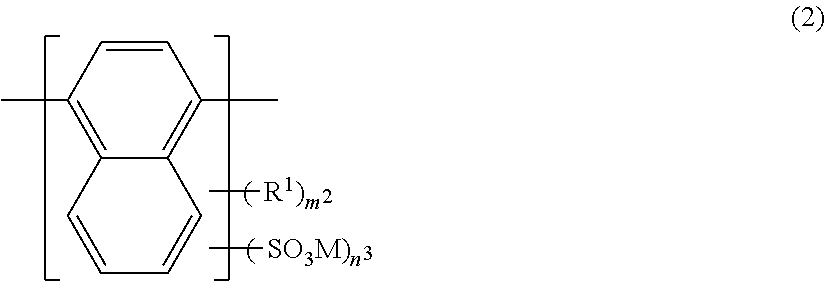Azo Compound Or Salt Thereof, And Dye-Based Polarizing Film And Dye-Based Polarizing Plate Containing Same
a technology of azo compound and dye polarizing plate, which is applied in the field of new azo compound or salt thereof, and a dye polarizing film containing the same, can solve the problems of poor durability, insufficient polarizing performance of dye polarizing film using dichroic dye, etc., and achieve high weather resistance
- Summary
- Abstract
- Description
- Claims
- Application Information
AI Technical Summary
Benefits of technology
Problems solved by technology
Method used
Image
Examples
example 1
(Step 1)
[0105]To 500 parts of water, 22.3 parts of 4-amino-1-naphthalenesulfonic acid was added, and dissolved by using a 25% sodium hydroxide; and thereafter, a 35% hydrochloric acid was added to adjust the pH to 0.2. To the obtained liquid, 17.3 parts of a 40% sodium nitrite aqueous solution was added to prepare a diazo liquid. Separately, to 200 parts of water, 22.3 parts of 8-aminonaphthalene-2-sulfonic acid was added, and was weakly alkalified with a 25% sodium hydroxide aqueous solution to be dissolved. To the resultant liquid, the previously obtained diazo liquid was dropped while keeping the pH at 4.5 to 6.0 and stirred to complete a coupling reaction. Thereafter, the resultant was salted out with sodium chloride, and thereafter filtered to obtain 122 parts of a wet cake of the monoazo compound represented by formula (28).
(Step 2)
[0106]To 300 parts of water, 122 parts of the obtained wet cake of the monoazo compound (28) was added, and stirred and suspended. The pH of the su...
example 2
(Step 1)
[0109]To 500 parts of water, 30.3 parts of 7-amino-1,3-naphthalenedisulfonic acid was added, and dissolved by using a 25% sodium hydroxide; and thereafter, a 35% hydrochloric acid was added to adjust the pH to 0.2. To the obtained liquid, 17.3 parts of a 40% sodium nitrite aqueous solution was added to prepare a diazo liquid. Separately, to 200 parts of water, 23.9 parts of 5-amino-1-naphthol-3-sulfonic acid was added, and was weakly alkalified with a 25% sodium hydroxide aqueous solution to be dissolved. To the resultant liquid, the previously obtained diazo liquid was dropped while keeping the pH at 4.5 to 6.0 and stirred to complete a coupling reaction. Thereafter, the resultant was salted out with sodium chloride, and thereafter filtered to obtain 129 parts of a wet cake of the monoazo compound represented by formula (30).
(Step 2)
[0110]To 300 parts of water, 129 parts of the obtained wet cake of the monoazo compound (30) was added, and stirred and suspended. The pH of th...
example 31
(Step 1)
[0114]To 200 parts of water, 31.9 parts of 4-amino-5-hydroxy-2,7-naphthalenedisulfonic acid was added, and dissolved by using a 25% sodium hydroxide; thereafter, 19.1 parts of 4-toluenesulfonyl chloride was dropped while keeping the pH at 10.5 to 11.0, and stirred to complete the reaction. Thereafter, the resultant was salted out with sodium chloride, and thereafter filtered to obtain 142 parts of a wet cake of the compound represented by formula (33).
(Step 2)
[0115]To 300 parts of water, 142 parts of the obtained wet cake of the compound (33) was added, and stirred and suspended. The pH of the suspension liquid was adjusted at 9.0 by using a 25% sodium hydroxide; and to the resultant, 15.5 parts of a 40% sodium nitrite aqueous solution was added. The obtained suspension liquid was dropped in a mixed liquid of 100 parts of water and 37.5 parts of a 35% hydrochloric acid to prepare a diazo liquid. Separately, to 200 parts of water, 20.1 parts of 8-aminonaphthalene-2-sulfonic a...
PUM
| Property | Measurement | Unit |
|---|---|---|
| absorption wavelength | aaaaa | aaaaa |
| absorption wavelength | aaaaa | aaaaa |
| wavelength | aaaaa | aaaaa |
Abstract
Description
Claims
Application Information
 Login to View More
Login to View More - R&D
- Intellectual Property
- Life Sciences
- Materials
- Tech Scout
- Unparalleled Data Quality
- Higher Quality Content
- 60% Fewer Hallucinations
Browse by: Latest US Patents, China's latest patents, Technical Efficacy Thesaurus, Application Domain, Technology Topic, Popular Technical Reports.
© 2025 PatSnap. All rights reserved.Legal|Privacy policy|Modern Slavery Act Transparency Statement|Sitemap|About US| Contact US: help@patsnap.com



